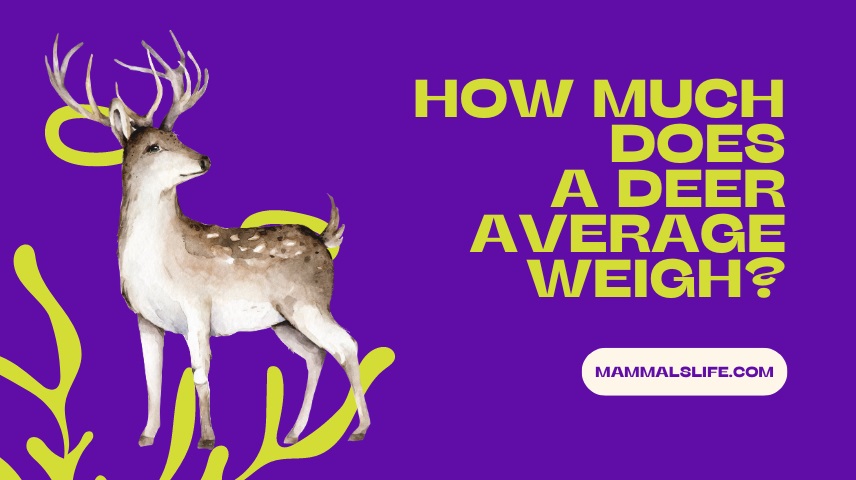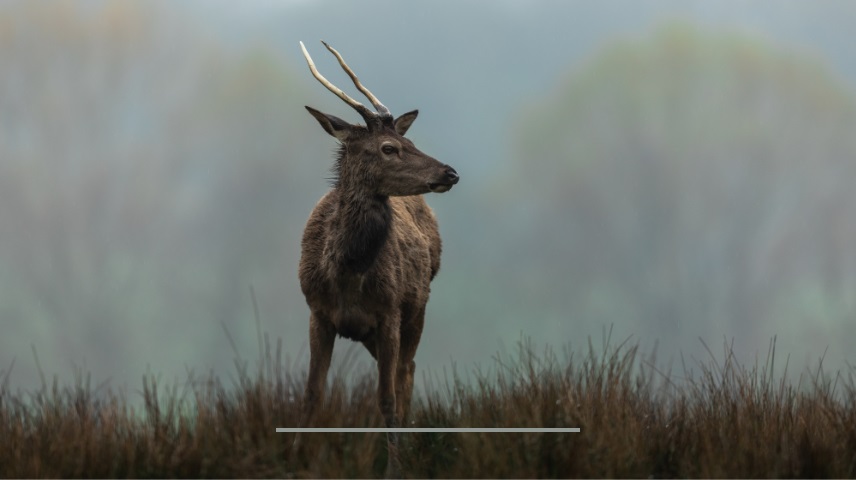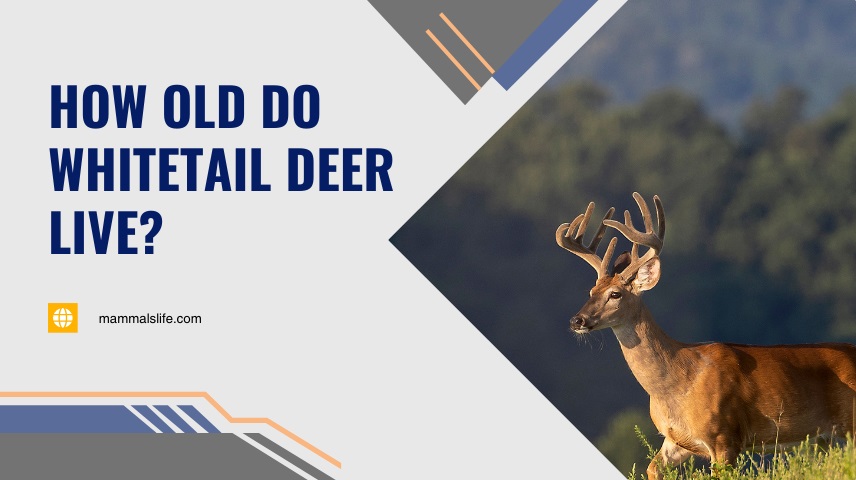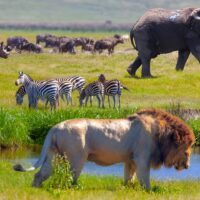Last Updated on February 22, 2025 by Mammals Life
An average adult deer weighs between 100 to 300 pounds. Weight varies by age and gender.
Deer weight fluctuates significantly based on age and gender. Fawns, or young deer, typically weigh between 30 to 70 pounds. Adult males, known as bucks, can weigh from 150 to 300 pounds, while adult females, or do, usually range between 100 to 200 pounds.
Factors such as diet, habitat, and species also contribute to these variations. Understanding deer weight helps in wildlife management and hunting practices. Knowing these details ensures responsible and sustainable interactions with deer populations, preserving their health and ecosystem balance. This concise guide provides insights into the weight differences among deer, aiding enthusiasts and professionals alike.
Average Weight Of Deer
Deer comes in various sizes and weights. The average weight of a deer depends on many factors. Typically, a healthy adult deer weighs between 150 to 300 pounds. The weight can vary greatly based on age, gender, and region.
Factors Influencing Weight
Several factors affect a deer’s weight:
- Age: Young deer weigh less than adults.
- Gender: Male deer (bucks) are heavier than female deer (does).
- Diet: A rich diet leads to a heavier deer.
- Health: Healthy deer weigh more.
Regional Differences
Deer weights also vary by region:
| Region | Average Weight |
|---|---|
| North America | 150-300 pounds |
| Europe | 120-250 pounds |
| Asia | 100-200 pounds |
Weight By Age
Understanding the weight of a deer by age helps in wildlife management and hunting. Deer weight varies significantly as they grow from fawns to adults. This section explores the weight range of deer based on their age.
Fawn Weight Range
Fawns are baby deer, and their weight can vary. At birth, a fawn typically weighs between 4 to 8 pounds. During the first few months, they experience rapid growth. By the time they are six months old, their weight can range from 60 to 100 pounds. This growth depends on factors like nutrition and habitat quality.
Adult Deer Weight
Adult deer showcase a broader weight range influenced by gender. A male deer, known as a buck, can weigh between 130 to 300 pounds. Bucks often weigh more due to their larger frame and muscle mass. On the other hand, female deer, called does, are lighter. A doe typically weighs between 90 to 200 pounds. The weight also varies by the species of deer and the region they inhabit.
Here is a table summarizing the weight range of deer by age and gender:
| Age | Weight Range |
|---|---|
| Fawn (0-6 months) | 4 to 100 pounds |
| Adult Buck | 130 to 300 pounds |
| Adult Doe | 90 to 200 pounds |
Understanding these weight ranges helps in conserving deer populations and planning hunting seasons. Proper knowledge ensures sustainable practices and maintains healthy ecosystems.
Weight By Gender
Deer weight varies significantly by gender. Male and female deer have different weight ranges. This difference is influenced by factors such as age, diet, and habitat. Understanding these variations helps in wildlife management and conservation efforts.
Male Deer Weight
Male deer, also known as bucks, typically weigh more than females. The average weight of a male deer can range from 150 to 300 pounds. Bucks are larger due to their muscular build and antlers. Below is a table showing the average weight of male deer by age:
| Age (Years) | Average Weight (Pounds) |
|---|---|
| 1 | 100-130 |
| 2 | 150-200 |
| 3 | 200-250 |
| 4+ | 250-300 |
Female Deer Weight
Female deer, also known as does, are generally lighter than males. The average weight of a female deer ranges from 90 to 200 pounds. It is smaller and does not have antlers. The table below shows the average weight of female deer by age:
| Age (Years) | Average Weight (Pounds) |
|---|---|
| 1 | 80-100 |
| 2 | 90-120 |
| 3 | 120-150 |
| 4+ | 150-200 |
Understanding the weight differences between male and female deer is crucial. It helps in making informed decisions in wildlife management. This knowledge also aids in the conservation of deer populations.
Seasonal Weight Changes
Deer experience significant seasonal weight changes due to various factors. These factors include food availability, weather conditions, and biological needs. Understanding these changes helps in wildlife management and conservation efforts.
Winter Weight
During winter, deer often face harsh weather and limited food. This leads to noticeable weight changes. Their bodies adapt to survive the cold months. They grow thicker fur and reduce activity to conserve energy.
- Male deer (bucks) can lose up to 20% of their body weight.
- Female deer (does) also lose weight, but less than bucks.
The table below shows the average winter weights for different deer by age:
| Age | Average Weight (Bucks) | Average Weight (Does) |
|---|---|---|
| 1 year | 60-80 lbs | 50-70 lbs |
| 2 years | 100-120 lbs | 80-100 lbs |
| 3 years | 140-160 lbs | 110-130 lbs |
Summer Weight
In summer, deer enjoy abundant food sources and milder weather. This period allows them to regain lost weight and build up reserves. Deer feed on various plants, including leaves, grasses, and fruits.
- Increased food intake leads to weight gain.
- Male deer prepare for the rutting season.
- Female deer need extra energy for nursing fawns.
On average, bucks can weigh 20-30% more in summer. Does also gain weight, but their increase is more moderate. The table below highlights average summer weights:
| Age | Average Weight (Bucks) | Average Weight (Does) |
|---|---|---|
| 1 year | 80-100 lbs | 70-90 lbs |
| 2 years | 120-140 lbs | 100-120 lbs |
| 3 years | 160-180 lbs | 130-150 lbs |
Impact Of Diet
The diet of a deer greatly impacts its weight. Quality and quantity of food influence growth. Both natural food sources and supplemental feeding play roles. Let’s explore these factors.
Natural Food Sources
Deer primarily eats plants, fruits, and nuts in the wild. Their diet changes with the seasons. In spring and summer, deer eat fresh leaves and grasses. In the fall, they consume acorns and apples. Winter diets include twigs and bark.
- Spring and Summer: Fresh leaves, grasses, and flowers
- Fall: Acorns, apples, and nuts
- Winter: Twigs, bark, and evergreen plants
A varied diet helps deer gain weight. Rich food sources contribute to stronger, healthier deer. Lack of food leads to weight loss and weaker animals.
Supplemental Feeding
Humans sometimes feed deer in winter. This helps when natural food is scarce. Supplemental feeding includes corn, hay, and specially formulated pellets. These foods provide essential nutrients.
| Food Type | Benefits |
|---|---|
| Corn | High energy content |
| Hay | Rich in fiber |
| Pellets | Balanced nutrition |
Supplemental feeding supports deer through harsh winters. This practice ensures they stay healthy and maintain weight. Overfeeding can cause health issues. Balance is crucial for optimal health.
Health And Weight
The weight of a deer is influenced by various health factors. Understanding these factors can help in assessing the overall health of the deer. Health issues can lead to significant weight variations among deer of the same age and gender.
Disease Impact
Diseases can greatly affect a deer’s weight. Common diseases in deer include Chronic Wasting Disease (CWD) and Epizootic Hemorrhagic Disease (EHD). These diseases cause weight loss and muscle wasting.
Below is a table showing the impact of common diseases on deer weight:
| Disease | Symptoms | Weight Impact |
|---|---|---|
| Chronic Wasting Disease (CWD) | Weight loss, muscle wasting | Significant weight reduction |
| Epizootic Hemorrhagic Disease (EHD) | Fever, swelling, weight loss | Moderate to severe weight loss |
Parasite Influence
Parasites also play a crucial role in affecting a deer’s weight. Internal parasites such as worms and external parasites like ticks can drain a deer’s nutrients.
- Internal parasites: These include stomach worms, lungworms, and liver flukes.
- External parasites: These include ticks, lice, and mites.
Parasites can cause anemia, loss of appetite, and overall poor health. This leads to weight loss and stunted growth in young deer.
Managing these health issues is essential for maintaining healthy deer populations. Regular health checks and proper management practices help in controlling diseases and parasites.
Frequently Asked Questions
How Much Does A 1-Year-Old Deer Weigh?
A 1-year-old deer typically weighs between 70 to 130 pounds. Weight can vary based on species and diet.
What Is A Deer’s Typical Weight?
A deer’s typical weight ranges from 100 to 300 pounds. Males usually weigh more than females. Different species and regions can affect weight.
How Old Is A 200 Lb Deer?
A 200 lb deer is typically 2-4 years old. Age varies based on diet, habitat, and genetics.
How Much Does A 4.5-Year-Old Deer Weigh?
A 4. 5-year-old deer typically weighs between 150 to 200 pounds. Weight varies by species and diet.
How Much Does An Average Deer Weigh?
An average deer weighs between 100 to 300 pounds.
Do Deer Weights Vary By Age?
Yes, younger deer weigh less than mature adults.
Conclusion
Understanding deer weight variations by age and gender helps in wildlife management. This knowledge aids in monitoring and conservation efforts. Knowing these details can improve your outdoor experiences and hunting success. Keep this information handy for future reference and ensure responsible wildlife practices.











